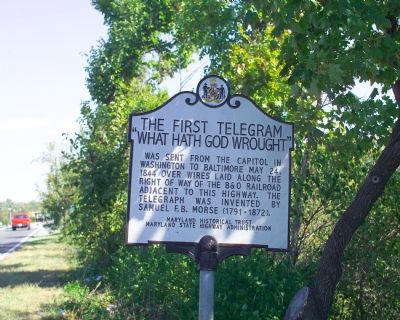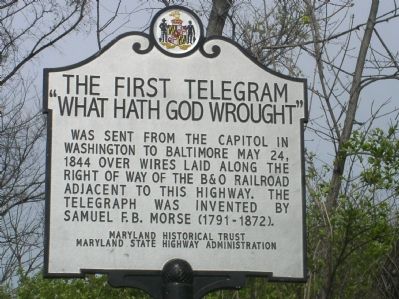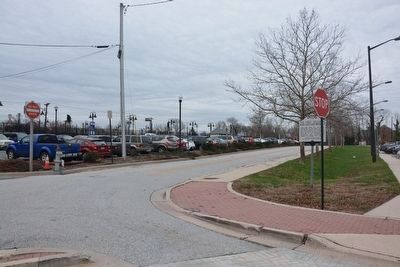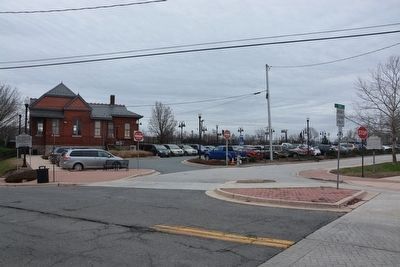Near Laurel in Prince George's County, Maryland — The American Northeast (Mid-Atlantic)
The First Telegram
“What Hath God Wrought”
The first telegram “WHAT HATH GOD WROUGHT” was sent from the Capitol in Washington to Baltimore May 24, 1844 over wires laid along the right of way of the B&O Railroad adjacent to this highway. The telegraph was invented by Samuel F.B. Morse (1791–1872).
Erected by the Maryland Historical Trust and the Maryland State Highway Administration.
Topics and series. This historical marker is listed in these topic lists: Communications • Notable Events. In addition, it is included in the Baltimore and Ohio Railroad (B&O) series list. A significant historical date for this entry is May 24, 1844.
Location. 39° 6.157′ N, 76° 50.526′ W. Marker is near Laurel, Maryland, in Prince George's County. Marker is at the intersection of Main St and 1st Street, on the right when traveling east on Main St. Marker is one block east of US Route 1. Touch for map. Marker is in this post office area: Laurel MD 20707, United States of America. Touch for directions.
Other nearby markers. At least 8 other markers are within walking distance of this marker. Laurel Railroad Depot (within shouting distance of this marker); World War II Memorial (about 500 feet away, measured in a direct line); Veterans Memorial (about 600 feet away); Welcome to… Marr Field (about 700 feet away); Buzzy's Pits (about 700 feet away); Garage and Blacksmith (about 800 feet away); First Garage in Laurel (about 800 feet away); Laurel: Half-way between Baltimore and Washington (approx. ¼ mile away). Touch for a list and map of all markers in Laurel.
More about this marker. This marker was moved from Beltsville to Laurel in December, 2015. It is no longer on the highway adjacent to the B&O Railroad.
Regarding The First Telegram. “What Hath God Wrought” was the text on the telegram, sent by Samuel Morse, located at the U.S. Capitol, to Alfred Vail, who was at the railroad station in Baltimore. The same words were telegraphed back to the capital a moment later.
This was the first long-distance telegram. Six years earlier, in Morristown, New Jersey, local telegrams were sent during development and demonstrations of the newly-invented telegraph.
Related marker. Click here for another marker that is related to this marker. - The invention of the telegraph.
Also see . . .
1. The Victorian Internet. The Remarkable Story of the Telegraph and the Nineteenth Century's On-line Pioneers. 2007 book by Tom Standage (Submitted on May 8, 2012.)
2. Telegraphy. Wikipedia entry:
“On Monday, 12 July 1999, a final telegram was sent
from the National Liberty Ship Memorial, the SS Jeremiah O'Brien, in San Francisco Bay to President Bill Clinton in the White House. ... They then transmitted the message to the White House via e-mail. That event was also used to mark the final commercial U.S. ship-to-shore telegraph message transmitted from North America by Globe Wireless, a company founded in 1911. Sent from its wireless station at Half Moon Bay, California, the sign-off message was a repeat of Samuel F. B. Morse's message 155 years earlier, ‘What hath God wrought’.”
“In the United States, Western Union sent its last telegram on January 27, 2006.” (Submitted on August 19, 2017.)
3. First around-the-world telegram sent, 66 years before Voyager II launch. History website entry:
“The New York Times decided to send its 1911 telegram in order to determine how fast a commercial message could be sent around the world by telegraph cable. The message, reading simply ‘This message sent around the world,’ left the dispatch room on the 17th floor of the Times building in New York at 7 p.m. on August 20. After it traveled more than 28,000 miles, being relayed by 16 different operators, through San Francisco, the Philippines, Hong Kong, Saigon, Singapore, Bombay, Malta, Lisbon and the Azores–among other locations–the reply was received by the same operator 16.5 minutes later” (Submitted on August 19, 2017.)
Additional commentary.
1. The Telegraph and the Railroad
The telegraph was an important method of communication and train control for much of the nineteenth and twentieth centuries. It allowed the development of the "manual block" system where a train's location was determined as being between two stations. Telegraph poles and lines were common sights on main lines throughout the United States. Telegraph has since been replaced by radio communication and Automatic Block Signals (ABS), which can be located at regular intervals determined by the maximum braking distance of a train.
— Submitted October 15, 2007, by Tom Fuchs of Greenbelt, Maryland.

Photographed By Tom Fuchs, October 13, 2007
4. The First Telegram Marker at Its Original Location
Marker was originally erected about 4 miles south on U.S. 1 just north of Md 212. When it was erected the B&O Railroad tracks that parallel the railroad could be seen from the roadway along with the since-removed railroad telegraph poles teeming with wires. By the time this photograph was taken, trees had obscured the view.
Credits. This page was last revised on April 22, 2024. It was originally submitted on April 14, 2007, by Dudeindacorner of Laurel, Maryland. This page has been viewed 4,887 times since then and 419 times this year. Last updated on January 23, 2016, by A. Taylor of Laurel, Maryland. It was the Marker of the Week August 20, 2017. Photos: 1. submitted on April 14, 2007, by Dudeindacorner of Laurel, Maryland. 2, 3. submitted on January 23, 2016, by A. Taylor of Laurel, Maryland. 4. submitted on October 15, 2007, by Tom Fuchs of Greenbelt, Maryland. • Bill Pfingsten was the editor who published this page.


